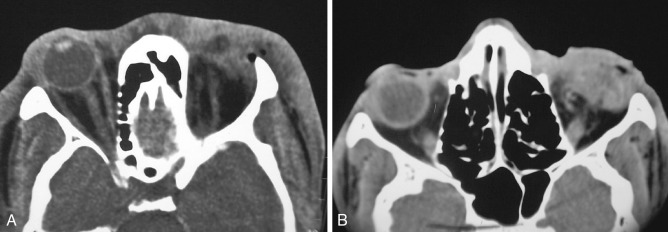Physical Address
304 North Cardinal St.
Dorchester Center, MA 02124
Definition: Ruptured globe (RG) occurs when the integrity of the eye is breeched by blunt or penetrating trauma causing full-thickness corneal or scleral breech. This is an ophthalmologic emergency.
Synonym: Shattered globe.
Classic clue: A man in his 30s with eye pain after having been struck by a projectile while carrying out a home-improvement project is sent by the emergency department with a request to “rule out (R/O) foreign body (FB).” A familiar “flat tire” appearance of the globe or abnormal air collection may be seen, but also look for more subtle findings like increased anterior chamber depth.
Computed tomography (CT) is the usual imaging procedure for orbital trauma.
Globe collapse may give a flat tire appearance (see Figure 7-2 , B ).

May see intraocular air or FB.
Thickened posterior sclera.
Hazy outline of the globe (see Figure 7-2 , B ).
Enlarged anterior chamber suggests posterior scleral rupture.
A discrepancy of at least 2 mm between anterior chamber depths raises the question of scleral rupture.
Traumatic posterior scleral rupture with vitreous decompression may allow lens retropulsion, thus deepening the anterior chamber.
Anterior chamber depth normally ranges from 2.5 to 3.5 mm, but varies according to age, sex, and measurement method.
Vitreous hemorrhage suggests retinal or choroidal tear, optic nerve avulsion, or FB.
Retinal tears, edema, detachments, and hemorrhage may be seen with RG.
Magnetic resonance (MRI) can clearly depict the orbital anatomy and pathology in multiple planes.
All CT findings listed above also apply to MRI, but CT is usually the initial imaging modality.
MRI is contraindicated if a metallic orbital FB is suspected.
Ultrasound can demonstrate the anatomy but may be contraindicated in certain trauma situations, particularly when perforation is present or suspected.
Become a Clinical Tree membership for Full access and enjoy Unlimited articles
If you are a member. Log in here